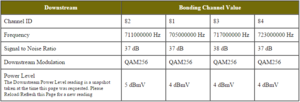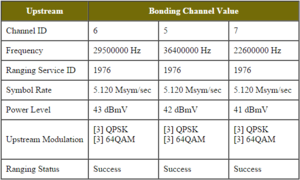Comcast Cable Modem - SNR, Power Level, Signal
Comcast cable modems can be problematic devices. When your internet is acting up you can check the signal information for your cable modem to see if there is an obvious problem. Most cable modems have a web interface that allows users to check the signal levels on their modem. Here is an explanation of the signal page for your cable modem.
Downstream

The downstream section is a list of channels you are connected to your ISP with. This manages one way communication to your modem, aka your download speed and signal strength. These numbers are measured at the cable modem itself.
Signal to Noise Ratio (SNR)
This is how clear the signal is. The higher the SNR the better the signal. There are multiple types of connections which each have their own recommended SNR.
- 256 QAM - 30 dB (33 dB Recommended)
- 64QAM - 24 dB (27 dB Recommended)
- 16QAM - 18 dB (21 dB Recommended)
- QPSK - 15 dB (15 dB Recommended)
Power Level
This is how powerful the signal is that is reaching your modem. This value has a "sweet spot", and can be a problem if the value is too high or too low.
- -7 dB to +7 dB - Recommended
- -10 dB to +10 dB - Acceptable
- -15dB to +15dB - Maximum
- beyond -15dB or +15dB - Out of Spec
Upstream

The upstream section lists the channels you are connect to your ISP with. Signal to Noise Ratio (SNR) is not listed on the upstream channels because it is measured at the CMTS. It is normal to have less upstream channels than downstream.
Power Level
This is a measure of how much power is in the upstream channels. This should be within a certain range, too high or too low can cause connection problems. If your power levels are too high for a given connections maximum it will be changed to another connection type to compensate which can result in speed problems.
- Normal Upstream Power Level - 35 dBmV to 49 dBmV
- Maximum for DOCSIS 3.0 - 52 dBmV
- Maximum for S-CDMA DOCSIS 2.0 - 53 dBmV
- Maximum for A-TDMA DOCSIS 2.0 - 54 dBmV
- Maximum for QPSK DOCSIS 1.0 - 58 dBmV
Signal Stats (Codewords)

This section relates to the downstream channels and how many errors there were. It measures how many codewords were fine (Total Unerrored Codewords), how many were bad but fixable (Total Correctable Codewords), and how many were bad and not fixable (Total Uncorrectable Codewords). Unerrored codewords should be higher than 99% of the sum of the three values.
- Problem!: greater than 1 in 100 uncorrectable codewords
- Problem?: greater than 1 in 1,000 uncorrectable codewords
- Acceptable: 1 in 100,000 uncorrectable codewords
- Ideal: 1 in 1,000,000 uncorrectable codewords
External Links
- DSLreports - Source of the numbers for this article
- Xfinity Forums - On the Xfinity (Comcast) forums, explains more signal strength info
- Speedguide.net - A simpler guide with cable modem specs